Welcome to my comprehensive guide on discus fish care! As a fish owner myself, I understand the importance of providing the best care possible for our aquatic pets. Discus fish are no exception – they require specific conditions and care to thrive and maintain their health. In this guide, I will share with you all the essentials you need to know to create the perfect environment for your discus fish to flourish. From setting up their tank to maintaining their health, I’ve got you covered. Let’s dive in!
Table of Contents
Key Takeaways
- Discus fish have specific requirements that set them apart from other freshwater fish species
- Creating the ideal environment for your discus fish is crucial for their overall well-being
- Maintaining optimal water quality and temperature is crucial for the health and vitality of discus fish
- Proper nutrition is paramount for the well-being of your discus fish
- Monitoring the behavior and health of your discus fish is essential for early detection of potential issues
Understanding the Unique Needs of Discus Fish Care
Welcome back to the essential guide to Discus Fish care. In this section, I will guide you through the unique needs of Discus Fish so you can provide them with the best possible care.
Water Parameters
Discus Fish require specific water parameters to thrive. These fish are sensitive to water conditions, and even slight changes can stress them out. You must maintain consistent water conditions by performing regular water tests and making necessary adjustments.
| Water Parameter | Ideal Range |
|---|---|
| Temperature | 82-86°F |
| pH Level | 6.0-6.5 |
| Hardness | 1-3 dGH |
Make sure to invest in a reliable thermometer and pH test kit to monitor these levels regularly.
Tank Size
Discus Fish require a spacious tank to swim around comfortably. As a rule of thumb, you should have at least 10 gallons of water per Discus Fish. Considering Discus Fish grow to be around 8-10 inches in length, a tank size of 50-75 gallons will provide ample swimming space for a group of Discus Fish.
Temperature Requirements
Discus Fish are tropical fish and require warm water to thrive. The ideal temperature range for Discus Fish is between 82-86°F. Invest in a reliable heater to maintain a consistent temperature in your tank.
By understanding these unique requirements, you can provide the best possible care for your Discus Fish. In the next section, I’ll guide you through the process of setting up the perfect Discus Fish tank.
Setting Up the Perfect Discus Fish Tank
Creating a comfortable and healthy environment for your discus fish is vital for their well-being. In this section, I will guide you through the essential steps of setting up the perfect discus fish tank.
Step 1: Choosing the Right Tank
The first step in setting up a discus fish tank is selecting the right size. Discus fish require a spacious tank to thrive, and the general rule is to have at least 10 gallons of water per fish. A 55-gallon tank is the ideal choice, allowing room for multiple fish and easy maintenance. Make sure the tank has a lid to prevent any jumping, and choose a location with minimal sunlight exposure and temperature fluctuations.
Step 2: Selecting the Right Substrate
Discus fish prefer a soft and fine-grained substrate. Avoid using rough gravel or sand that may injure their delicate fins. A good option is to use aquarium sand or special discus fish substrate to create a natural-looking environment. Ensure the substrate is shallow, no more than 2 inches deep as discus fish like to sift through it to find food.
Step 3: Installing the Right Equipment
Equipping your tank with the proper equipment is crucial in maintaining a healthy and stress-free environment for discus fish. You will need a sturdy filter to keep the water clean and aerated, a heater to maintain a consistent temperature of 82-86°F, and a thermometer to monitor the water temperature. A high-quality water testing kit is also essential to ensure the water parameters meet discus fish requirements.
Step 4: Establishing the Ideal Water Conditions
Discus fish require specific water conditions to thrive. The pH level should be between 6.0-7.5, with a hardness of 1-8 dGH. Ideally, the aquarium water should be dechlorinated, to remove any harmful chemicals that can be present in tap water. Use reverse osmosis or distilled water for water changes to avoid introducing unwanted chemicals into the tank.
Step 5: Adding Decorations and Plants
Decorations and live plants are essential to create a natural-looking environment for discus fish. Choose decorations that mimic their natural habitat such as driftwood and smooth rocks. Avoid sharp and rough objects that may harm their fins. Live plants such as Amazon sword plants and Java fern not only provide oxygen and filtration but also create a peaceful and calming environment for your discus fish.
| Discus Fish Tank Setup Checklist: |
|---|
| • Tank size of at least 55 gallons |
| • Soft and fine-grained substrate |
| • Filter, heater, thermometer, and water testing kit |
| • Ideal water conditions: pH 6.0-7.5, hardness 1-8 dGH, and dechlorinated water |
| • Decorations and live plants |
By following these guidelines for creating a discus fish tank, you will provide your fish with a healthy and stimulating environment that will help them thrive. In the next section, I’ll cover all the essential steps for maintaining ideal water quality and temperature.
Maintaining Water Quality and Temperature
As mentioned earlier, maintaining optimal water quality and temperature is vital for the health and vitality of your discus fish. Here are some essential discus fish care instructions on how to ensure the water conditions in your tank remain stable.
Checking Water Parameters
Regularly monitoring the water parameters of your tank is crucial for maintaining a healthy environment for your discus fish. Use a reliable water testing kit to check the levels of ammonia, nitrites, nitrates, pH, and temperature.
The optimal water parameters for discus fish care are:
| Parameter | Ideal Level |
|---|---|
| Ammonia | 0 ppm |
| Nitrite | 0 ppm |
| Nitrate | less than 20 ppm |
| pH | 6.0-7.5 |
| Temperature | 82-86° F |
If you notice any irregularities in the water parameters, take appropriate steps to correct them immediately. Maintaining stable water conditions is crucial for the health of your discus fish.
Performing Water Changes
Regular water changes are essential for discus fish care. Aim for a 25-30% water change every week to keep the water quality in your tank optimal. During water changes, siphon waste and debris from the substrate to prevent the accumulation of harmful bacteria and toxins.
Cleaning the Filter
Regularly cleaning the filter is crucial for maintaining optimal water quality in your tank. Aim to clean the filter media once a month to prevent the accumulation of waste and debris.
Adjusting Water Temperature
Discus fish require warm water temperatures for optimal health. Use a reliable aquarium heater to maintain water temperatures between 82-86° F. Avoid sudden temperature fluctuations, as this can cause stress and illness in your fish.
By implementing these discus fish care essentials, you can maintain a clean and stable environment for your discus fish, promoting their health and well-being.
Feeding Discus Fish for Optimal Health
When it comes to caring for your discus fish, providing them with proper nutrition is paramount. Feeding your fish a balanced diet is essential for their growth, vibrancy, and overall health. In this section, I’ll cover everything you need to know about feeding your discus fish.
Discus Fish Feeding Schedule
Discus fish should be fed small meals multiple times a day to ensure they receive adequate nutrition without overfeeding. As a general rule, aim to feed your fish 3-5 times a day, with each meal being no larger than what the fish can finish in 2-3 minutes.
Discus Fish Dietary Needs
Discus fish are omnivores, which means they eat both meat and vegetables. A well-balanced diet for discus fish should consist of high-quality protein, such as brine shrimp, bloodworms, and beef heart, as well as vegetable matter, such as spirulina and algae wafers.
Feeding Techniques
When feeding your discus fish, it’s essential to avoid overfeeding, as this can lead to health issues such as bloating and constipation. It’s also important to ensure that the food is suitable for the size of the fish’s mouth. Small pellet or flake food is ideal for young discus fish, while larger pellets or frozen food are better suited for adult fish.
Preventing Overfeeding
Overfeeding is one of the most common mistakes made by discus fish owners. To prevent overfeeding, measure out the amount of food your fish requires for each meal and avoid adding more food until the previous meal has been fully consumed. Additionally, avoid feeding your fish scraps or human food, as this can lead to digestive issues.
Tip: If you’re unsure how much food to feed your discus fish, start with a small amount and adjust accordingly based on their appetite and growth rate.
Feeding your discus fish a well-balanced diet is essential for their overall health and vitality. Follow these feeding guidelines to keep your fish thriving!
Maintaining a Clean Discus Fish Tank
Keeping your discus fish tank clean is crucial for the overall health and well-being of your vibrant pets. Regular maintenance and cleaning will prevent the buildup of harmful toxins and ensure a safe environment for your fish to thrive.
Water Changes
One of the most critical aspects of tank maintenance is ensuring proper water quality. Regular water changes are essential to remove excess waste and debris, preventing the accumulation of harmful substances and bacteria. As a general rule, aim to change 10-20% of the water in your discus fish tank every week.
When performing water changes, it’s essential to use a water conditioner to neutralize any chlorine or chloramine in your tap water. Additionally, make sure the new water you add to the tank matches the same temperature and pH as the existing water to prevent shock to your fish.
Filter Maintenance
Your tank’s filtration system is responsible for removing impurities and maintaining optimal water quality. Regularly cleaning and maintaining your filter is crucial for ensuring it functions correctly and effectively removes harmful substances from the water.
When cleaning your filter, make sure to follow the manufacturer’s instructions carefully. Generally, it’s recommended to rinse mechanical filter media with tank water every month and replace it every 6-12 months, depending on usage. Biological filter media should not be replaced unless it is physically damaged or exhausted.
Substrate Upkeep
The substrate, or the material at the bottom of your tank, can harbor harmful bacteria and waste, making regular maintenance crucial. If you have a planted tank, vacuuming the substrate is essential to prevent the accumulation of organic debris that can lead to algae growth.
When vacuuming, make sure not to disturb the substrate too much, as this can release harmful toxins into the water. Aim to vacuum around 10-20% of the substrate every week, depending on your tank’s bioload.
Pro tip:
While cleaning your tank, observe your discus fish for any signs of stress or illness. If you notice any abnormal behavior or physical symptoms, address the issue promptly to prevent further complications.
Regularly maintaining your discus fish tank is essential for ensuring the long-term health and well-being of your vibrant pets. By following these simple tips, you can create a clean and safe environment that allows your discus fish to thrive.
Monitoring Discus Fish Behavior and Health

In order to maintain the health of your discus fish, it’s important to keep a close eye on their behavior and appearance. Changes in behavior or physical appearance can indicate stress, disease, or other issues that require attention.
Behavioral Signs of Stress
One of the most common indicators of stress in discus fish is a change in behavior. If your fish start to hide or swim erratically, it may be a sign that they are stressed. Other behavioral signs of stress include:
- Reduced appetite
- Aggressive behavior towards tank mates
- Excessive scratching or rubbing against tank objects
- Gasping at the surface of the water
If you notice any of these behaviors in your discus fish, it’s important to take action to relieve their stress. This can include adjusting water conditions or removing potential stressors from their environment.
Physical Signs of Disease
Discus fish are prone to several diseases that can impact their health. It’s important to regularly inspect your fish for any physical signs of illness, so you can address it promptly and prevent it from spreading to other fish in the tank. Common physical signs of disease in discus fish include:
- White spots or patches on fins or body (indicative of ich)
- Red sores or ulcers on body or fins
- Clamped fins or fins that appear frayed or torn
- Swollen or bloated appearance
If you notice any of these symptoms, it’s important to isolate the affected fish, treat the tank with appropriate medication, and adjust water conditions as needed to prevent further spread of the disease.
“By monitoring your discus fish’s behavior and health, you can quickly identify and address any potential issues that may arise. Regular observation is the key to maintaining a healthy and happy discus fish family.
Creating the Right Social Environment for Discus Fish
Discus fish are known for their social nature, and creating the right social environment is essential for their mental well-being. As a discus fish owner, you have to take some necessary steps to make sure your fish live in a harmonious environment.
The first thing to consider is the tank size. Discus fish require a larger tank than most freshwater fish, and overcrowding the tank can lead to aggression and stress. Ensure that each fish has enough space to move around without being constantly chased or threatened by others.
Another critical factor to consider is selecting suitable tank mates. Not all fish species are compatible with discus fish, and choosing the wrong companions can lead to conflicts and harm. Ideally, you can select other peaceful species that have similar water requirements and temperaments.
Understanding the hierarchy of discus fish is also important. Discus fish are known to establish a pecking order, with dominant fish at the top of the hierarchy and submissive fish at the bottom. As such, it’s crucial to avoid adding too many fish at the same time, as this can upset the established hierarchy and cause stress and fights.
Finally, providing hiding spots and appropriate tank decor can help reduce stress and maintain peace in the tank. Discus fish love to have hiding places to retreat to when feeling threatened or stressed. You can add rocks, plants, and other decorations to create natural-looking hiding spots that will make your fish feel secure.
Common Discus Fish Tank Mates
| Fish Species | Comments |
|---|---|
| Cardinal tetras | Peaceful and colorful, great in larger schools |
| Corydoras catfish | Bottom-dwellers, helps to clean up food scraps and other debris. |
| Bristlenose plecos | Herbivores that help keep the tank clean, don’t produce much waste |
| Otocinclus catfish | Algae-eaters, good for keeping the tank clean |
| German Blue Rams | Small and peaceful, great colors and patterns |
By following these guidelines and considering your discus fish’s unique needs, you can create a social environment that supports their mental well-being and promotes harmonious living. Remember to monitor your fish’s behavior for any signs of stress or aggression and make adjustments as needed to ensure they continue to thrive.
Breeding Discus Fish Successfully
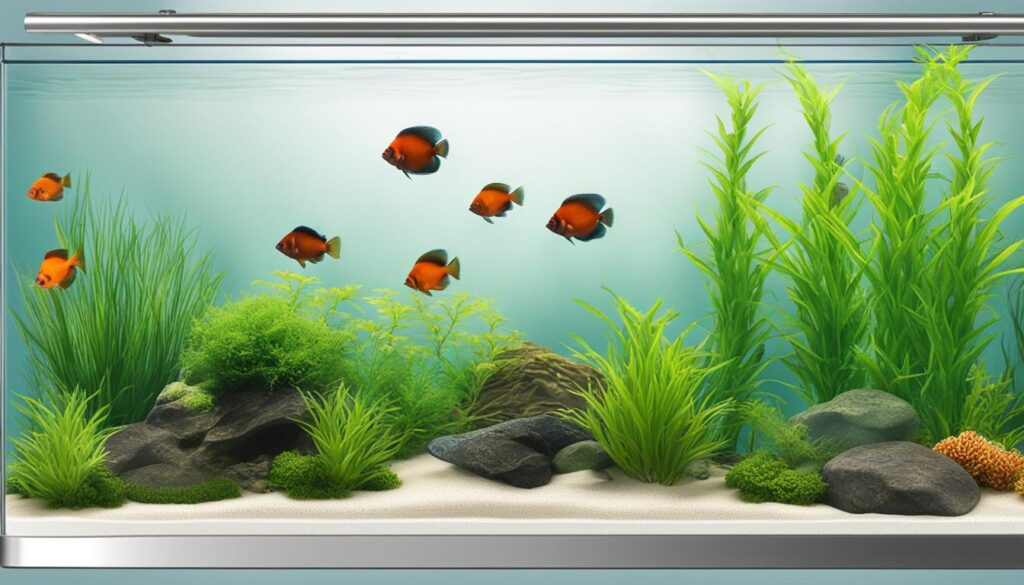
Breeding discus fish is a fascinating and rewarding activity for any fishkeeper. However, it requires careful planning and attention to detail. In this section, I’ll guide you through the key steps and considerations for successfully breeding discus fish. By the end of this section, you’ll be equipped with the knowledge to embark on this exciting journey.
Choosing Breeding Pairs
The first step in breeding discus fish is selecting a suitable breeding pair. When choosing breeding pairs, it’s essential to select healthy and mature fish. Look for signs of good health, such as bright colors, active swimming, and full fins. Additionally, consider the compatibility of the pair. Discus fish are known for their territorial nature, so choose pairs that get along well and exhibit similar traits and characteristics.
Creating Optimal Breeding Conditions
Creating the right breeding conditions is critical for the success of your breeding project. Firstly, ensure that the breeding tank is large enough to accommodate the pair comfortably. A standard 30-gallon breeding tank is suitable for a breeding pair. Secondly, maintain the water temperature between 82 and 86 degrees Fahrenheit and ensure that the pH level is between 6.0 to 6.5.
Maintaining the Breeding Tank
It’s essential to keep the breeding tank clean and well-maintained to ensure the health and safety of the breeding pair and their fry. Regularly monitor the water parameters and perform frequent water changes to maintain stable and clean water conditions. Ensure that the breeding tank’s filtration system is working effectively and adequately aerating the water. Additionally, perform regular tank maintenance to keep the breeding tank free from debris and harmful contaminants.
Feeding Fry and Juvenile Discus Fish
Once the fry have hatched, feed them with freshly hatched brine shrimp or appropriately sized commercial fry food. As the fry grow and mature into juvenile discus fish, gradually introduce them to larger food particles such as crushed flakes and pellets. Ensure that the fry and juvenile fish receive a balanced diet and avoid overfeeding them.
Dealing with Common Discus Fish Challenges
As much as we try to provide the best care for our discus fish, they may still encounter certain challenges. In this section, I’ll address some common issues and offer solutions to ensure the optimal health of your discus fish.
Fin Rot
Fin rot is a common bacterial infection that affects the fins and tail of discus fish. The fins may appear ragged, frayed, and discolored. To treat fin rot, you’ll need to isolate the affected fish and administer antibiotics, which can be purchased from your local pet store. You should also maintain optimal water quality and temperature to prevent further infections.
Ich
Ich is a parasitic infection that often afflicts discus fish. Symptoms include white spots that appear on the fish’s body, fins, and gills. To treat ich, you can use a medication specifically designed for this condition, which is available at your local pet store. Additionally, you should increase the temperature of the tank to accelerate the life cycle of the parasite and conduct regular water changes to prevent further infections.
Swim Bladder Disorder
Swim bladder disorder is a condition that occurs when a fish’s swim bladder becomes inflamed, which affects their ability to swim properly. Symptoms include difficulty swimming, floating on one side, or sinking to the bottom of the tank. To treat swim bladder disorder, you can try fasting the affected fish for a few days or feeding them peas, which act as a natural laxative. If the condition persists, you should consult with a veterinarian to rule out any underlying health issues.
Behavioral Issues
Discus fish are known for their social nature, but they may sometimes exhibit aggressive or territorial behavior. If you notice any signs of fighting or bullying among your fish, you may need to rearrange your tank’s decor or add more hiding places to create separate territories. Additionally, you should ensure that you have the appropriate number of fish in your tank, as overcrowding can also lead to aggressive behavior.
Stress
Stress can have a significant impact on the health of your discus fish and can manifest in different ways, such as changes in appetite, color, or behavior. To minimize stress, you should maintain consistent water conditions, avoid sudden changes in lighting or temperature, and limit disturbances to the tank. You can also add plants or decorations to create a more natural and calming environment for your fish.
By addressing these common challenges promptly, you can prevent further health issues and ensure the long-term well-being of your discus fish. Remember to monitor your fish’s behavior and health regularly and seek professional advice if needed.
Enhancing the Beauty of Your Discus Fish
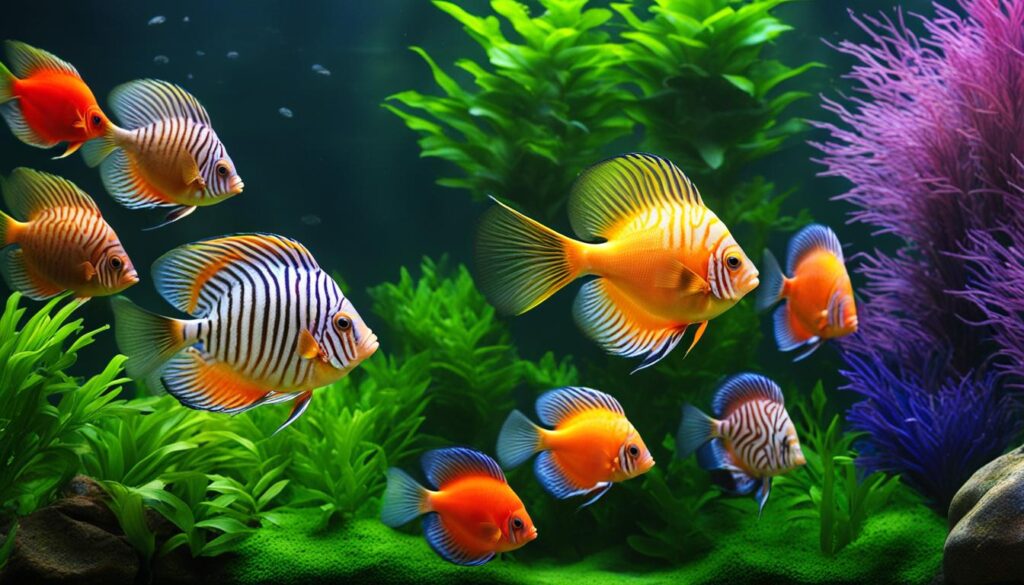
If you’re a discus fish owner, you know that your fish are not only gorgeous but also have unique personalities. In this section, I’ll provide you with some tips for enhancing your discus fish’s beauty and ensuring they remain healthy and happy in their environment.
1. Lighting
One way to enhance the beauty of your discus fish is to ensure they have proper lighting. Investing in high-quality lighting not only makes your fish look more vibrant but also promotes healthy plant growth and improves the overall aesthetic of your tank. When choosing lighting, consider the size of your tank and the needs of your individual fish.
2. Tank Decor
The right tank decor can make all the difference in enhancing your discus fish’s beauty. Choose decorations that complement the colors and patterns of your fish, and consider adding live plants to your tank to create a more natural and visually appealing environment. Just be sure any decorations you add are safe for your fish and won’t harm them.
3. Fish Selection
When selecting discus fish for your tank, consider their colors and patterns. Different strains of discus have unique coloration and patterns, so choosing a variety can add visual interest to your tank. Be sure to research the specific breed you’re interested in to ensure it’s compatible with your current fish and environment.
4. Water Quality
Ensuring proper water quality is essential for the health and beauty of your discus fish. Regularly testing your tank’s water and maintaining appropriate levels of pH, ammonia, and nitrate will help promote vibrant coloration and overall health in your fish.
5. Feeding
Proper feeding is crucial for the well-being of your discus fish and can also enhance their beauty. A balanced diet of high-quality food will keep your fish healthy and promote vibrant colors. Be sure to feed your fish a variety of foods, including pellets, flakes, and frozen or live foods.
By following these tips, you can enhance the beauty of your discus fish and ensure they thrive in their environment. Remember to always prioritize the well-being of your fish and create a habitat that meets their unique needs.
Conclusion
As a discus fish enthusiast, I know firsthand how rewarding it can be to care for these vibrant and social creatures. By following the guidelines and tips outlined in this comprehensive guide, you can create an ideal environment that allows your discus fish to thrive. Remember, discus fish have specific needs that must be met to ensure their well-being and longevity.
In this guide, I covered everything from understanding their unique requirements to setting up the perfect tank, maintaining water quality and temperature, feeding, breeding, and addressing common challenges. I also shared tips to enhance the beauty of your discus fish, including proper lighting and tank decor.
With the right care and attention, your discus fish can live happy and healthy lives, showcasing their stunning colors and patterns for years to come. So dive into this exciting hobby and watch your discus fish flourish!
FAQ
What are the unique needs of discus fish?
Discus fish have specific requirements when it comes to water parameters, tank size, and temperature. Understanding and meeting these needs is crucial for their well-being.
How do I set up the perfect discus fish tank?
Setting up a discus fish tank involves selecting the right equipment and establishing the ideal water conditions. I’ll guide you through the step-by-step process to ensure your fish have a comfortable habitat.
How can I maintain water quality and temperature for my discus fish?
Maintaining optimal water quality and temperature is vital for the health of discus fish. I’ll provide practical tips and techniques to help you monitor and adjust these important parameters.
What should I feed my discus fish?
Proper nutrition is crucial for discus fish. I’ll discuss their dietary needs and provide a feeding schedule that promotes their growth and vibrant colors. You’ll also learn about the best types of food to offer and how to prevent overfeeding.
How do I keep my discus fish tank clean?
Regular tank maintenance is essential for the overall health of your discus fish. I’ll share effective strategies for water changes, filter cleaning, and substrate upkeep to ensure your tank remains pristine.
How can I monitor the behavior and health of my discus fish?
Keeping a close eye on your discus fish’s behavior and health is important for early detection of any issues. I’ll provide valuable insights into common signs of stress or disease and how to address them promptly.
How do I create a harmonious social environment for my discus fish?
Discus fish are social creatures, and providing the right environment is crucial for their well-being. I’ll explain how to select compatible tank mates and create a harmonious social structure within your tank.
What do I need to know about breeding discus fish?
Breeding discus fish can be a rewarding experience. I’ll guide you through the key steps and considerations to successfully breed discus fish, including selecting breeding pairs and creating the ideal breeding conditions.
How do I deal with common challenges that may arise with discus fish?
Despite your best efforts, discus fish may face certain challenges such as fin rot or ich. I’ll address common issues and provide guidance on how to identify, treat, and prevent these challenges to ensure the long-term health of your discus fish.
How can I enhance the beauty of my discus fish?
Discus fish are known for their stunning colors. I’ll share tips and techniques to enhance their beauty, including proper lighting and tank decor choices that showcase the full splendor of your vibrant pets.
References
The International Discus Association (IDA)
The Discus World International (DWI)
The South American Cichlid Association (SACA)
Please also check out other articles on this website like
Master Breeding Techniques for Angelfish – A Guide for Hobbyists
Mastering Dwarf Puffer Fish Care: A Friendly Guide
Male or Female Betta? How to Tell – Your Ultimate Guide
Complete Guide to Plecostomus Tank Size: Tips and Advice
Simple Guide to Easy-to-Care-for Aquarium Plants
Discover the Diverse Corydoras Catfish Varieties- A Guide
Get to Know Various Types of Algae Eaters
Master Guide: Best Water Parameters for Goldfish Care 2023-24
Mastering Black Ghost Knife Fish Care: A Comprehensive Guide
Optimal pH Levels for Tropical Fish: Essential Aquarium Guide
Discovering Freshwater Snail Species: An In-depth Guide
Expert Tips for Breeding Guppies: Keys to Successful Fishkeeping
Discover Peaceful Community Fish: Your Guide to Calm Aquatics
Ultimate Guide to Live Food for Betta Fish — Healthy Choices
Complete Guide to Your Perfect Cichlid Tank Setup
Your Guide to the Best Substrate for Planted Aquariums
Essential Guide to Discus Fish Care: Help Your Pets Thrive!
Grow Your Own Eden: Beginner-Friendly Aquascaping Plants Guide
I am a passionate aquarist with over 30 years of hands-on experience in fishkeeping. My journey began at a young age, collecting fish from the wild and learning through experimentation. Specializing in tropical fish, I bring a deep understanding of the hobby to FishKeepingMadeSimple. The site provides honest, detailed reviews of essential products and accessories to help fellow enthusiasts create the best environments for their fish.

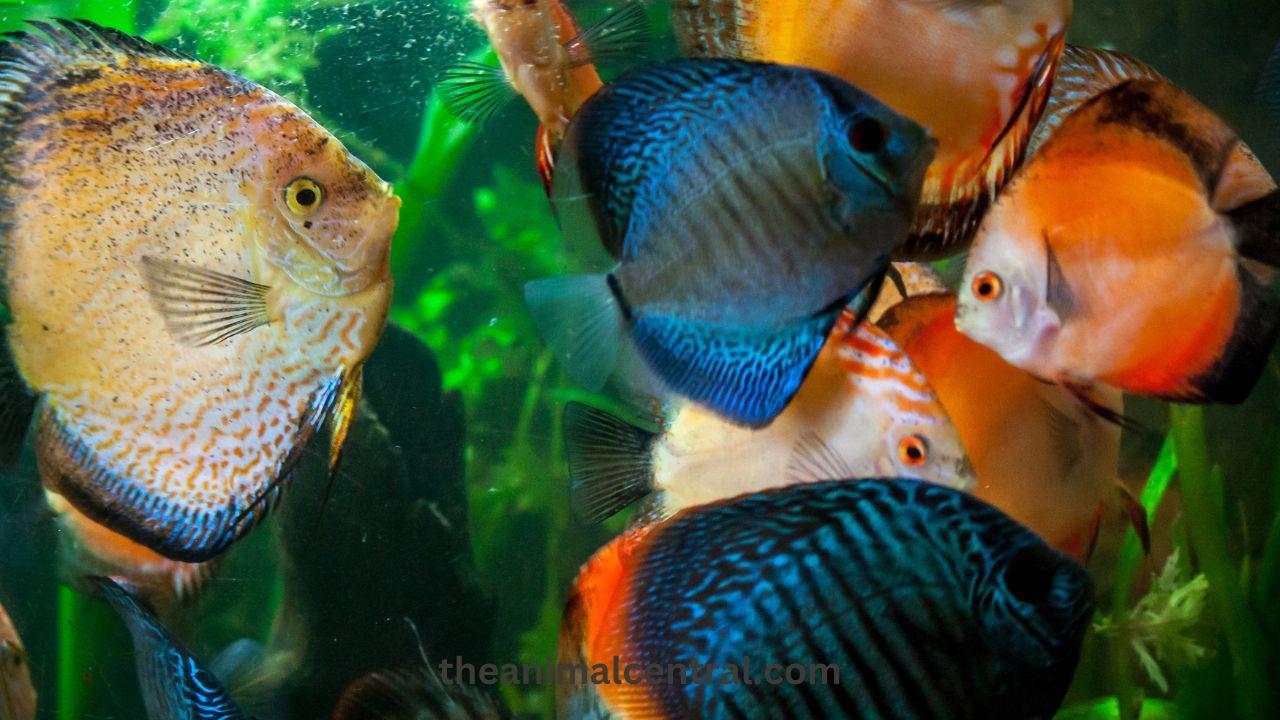
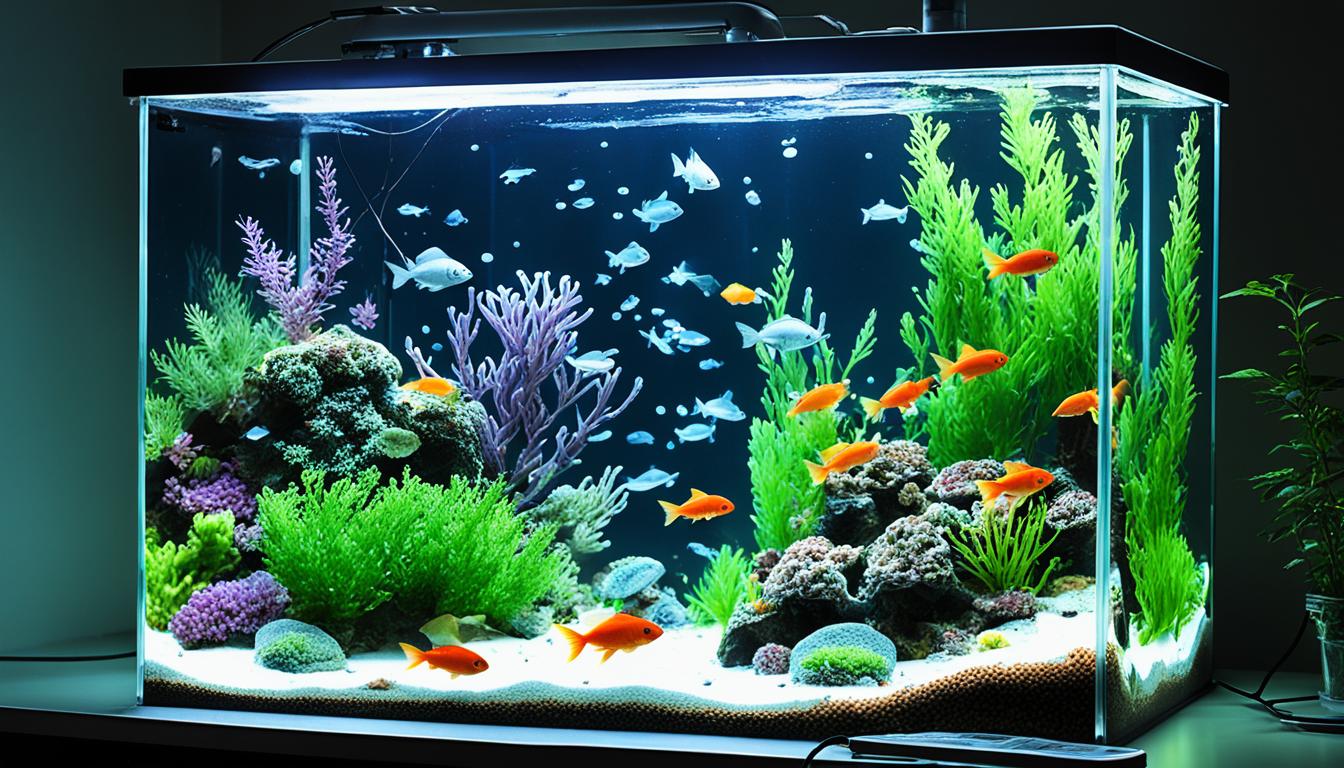
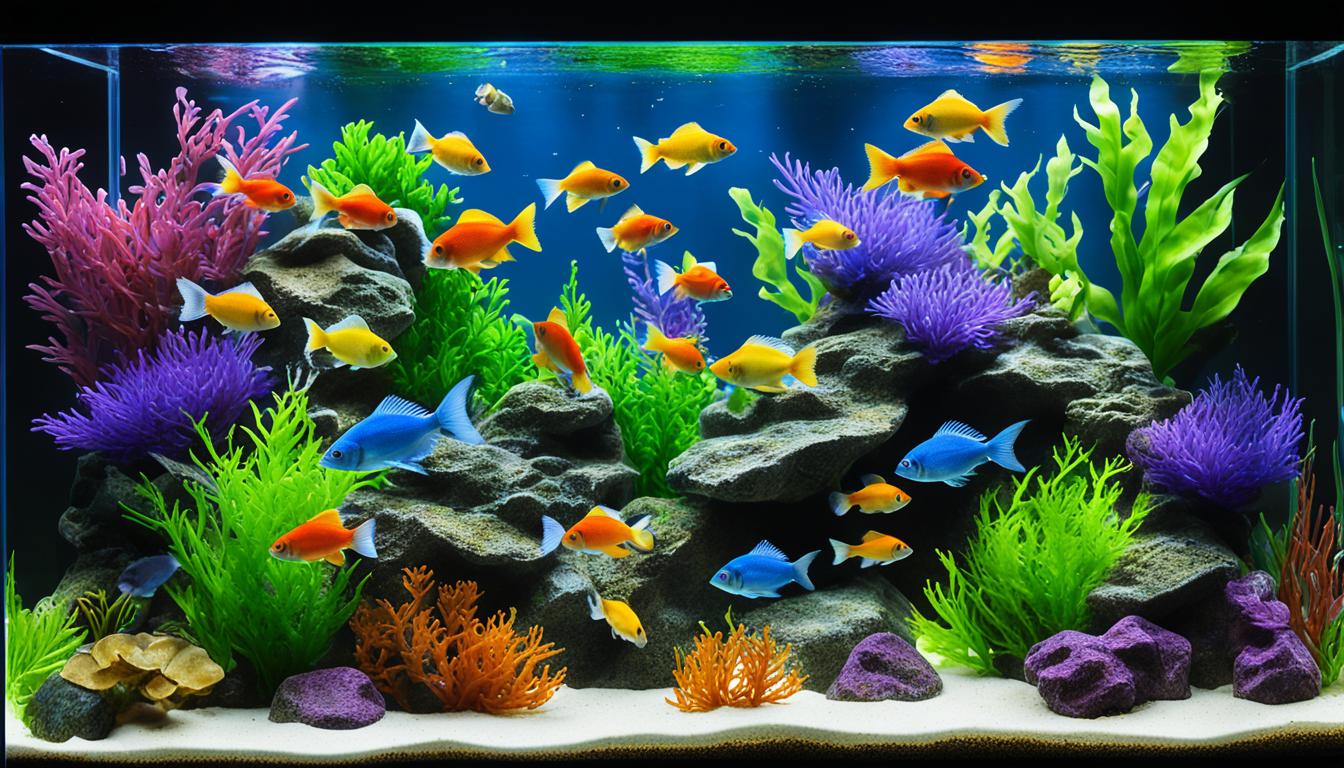









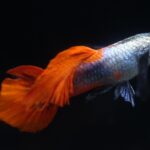
[…] changing the tank’s water, monitoring water quality, and avoiding overfeeding are basic pet care routines that can help prevent and treat fish parasites. It is also important to clean any decorative figures and plants regularly and avoid […]
[…] them with a healthy and comfortable habitat, you need to follow the right set up. A properly set up discus fish tank is key to keeping these beautiful fish happy and […]
[…] summary, understanding the behavior of discus fish is essential when keeping them with other fish, such as angelfish. They require a stable and consistent […]
[…] diseases is essential to maintaining the well-being of your platy fish. Here are some preventive measures to keep in […]
[…] fish thrive in social groups of at least five individuals, showing their peaceful and social […]
[…] important to note that some species may have a narrower pH range than others. For example, Discus fish have a preferred pH range of 5.5 to 6.5, while African cichlids prefer a higher pH range of 7.8 to […]
[…] discus fish is essential for determining the gender of your fish […]